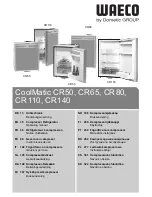
5
USING YOUR REFRIGERATOR
Switching on your refrigerator
1 Before connecting the refrigerator to the mains supply make sure
that the thermostat control dial located inside the refrigerator
compartment, is set between 3 to 4 but closer to 3, which is the
correct setting for use in a room of average temperature.
2 Wait 24 hours before placing food in the cabinet to allow for the
refrigerator to fall to the correct temperature.
Is the refrigerator cold enough?
If you are concerned that your refrigerator is not being kept cold enough,
and wish to check the temperature, you will need a special refrigerator/
freezer thermometer available from most supermarkets and hardware
shops. Place the thermometer on the middle shelf of the refrigerator,
where it can be read easily. Leave overnight, the temperature in the
refrigerator should be between 1ºC and 5ºC.
Adjusting the temperature
The internal temperature of your refrigerator is controlled by the
thermostat control dial. There are 7 settings. Position 8 makes the
refrigerator coldest. Position 1 makes it the warmest. To adjust the
temperature turn the thermostat control dial to the preferred setting.
Position 0 will turn the refrigerator off.
Noises inside the refrigerator!
If you have not owned a refrigerator before, you may notice that it makes
some rather unusual noises. Most of these are perfectly normal, but you
should be aware of them!
Gurgling, whooshing
These noises are caused by the circulation of the refrigerant liquid in the
cooling system. It has become more pronounced since the introduction
of CFC free gases. This is not a fault and will not affect the performance
of your refrigerator.
Humming, purring or pulsating
This is the compressor motor working, as it pumps the refrigerant around
the system.
Shopping for chilled foods
Don’t buy in your lunch hour!
Unless you have a refrigerator at work to keep the food cold in the
afternoon. Leaving food in your car or at room temperature for a
prolonged period of time could raise food temperature to the level at
which harmful bacteria grow.
Keep chilled foods together
When you are going around the supermarket and when you are travelling
home. If you keep all the chilled foods together they will help to keep each
other cold.
Use a cool bag
Special insulated bags can be bought from most supermarkets and
hardware shops. These keep food cold for longer, but are only for getting
chilled foods home, not storing it.
Unwrap as soon as you get home
Always unpack and place chilled foods in the refrigerator before storing
dry food-stuffs.
Tips for keeping food perfect in
the refrigerator
Take extra care with meat and fish
Cooked meats should always be stored on a shelf above raw meats to
avoid bacterial transfer. Keep raw meats on a plate which is large enough
to collect juices and cover it with cling film or foil.
Leave space around food
This will allow cold air to circulate around the refrigerator.
Wrap up food!
To prevent transfer of flavours and drying out, food should be separately
packed or covered. Fruit and vegetables need not be wrapped.
Let pre-cooked food cool properly
Always let pre-cooked food cool down before you put it in the refrigerator.
This will stop the internal temperature of the refrigerator from rising.
Shut the door!
To prevent cold air escaping, limit the number of times you open the door.
When returning from shopping, sort foods to be kept in your refrigerator
while the door is closed.
THERMOSTAT CONTROL DIAL
Summary of Contents for MUR49100
Page 1: ...How to use your new Refrigerator Model MUR49100...
Page 2: ......
Page 9: ......
Page 11: ...NOTES 11...
Page 12: ......






























